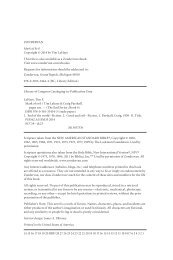A Chicken's Guide to Talking Turkey with Your Kids about Sex ...
A Chicken's Guide to Talking Turkey with Your Kids about Sex ...
A Chicken's Guide to Talking Turkey with Your Kids about Sex ...
You also want an ePaper? Increase the reach of your titles
YUMPU automatically turns print PDFs into web optimized ePapers that Google loves.
Chapter 1: It’s a Tough Job, but Someone Has <strong>to</strong> Do ItAt the very start, we want <strong>to</strong> commend you for taking the time andmaking the effort <strong>to</strong> become better informed and better equipped. Somany parents take the ostrich approach, burying their heads in the sandwhile they hope their children come out okay.That’s flat-out dangerous. As soon as your children hit puberty, theyare actively thinking <strong>about</strong> their bodies, talking <strong>about</strong> sex, and sortingthrough the conflicting messages they get from their peers and society.If you leave them <strong>to</strong> do this on their own, you’re abandoning them <strong>to</strong>the lure of their hormones, the seduction of false and twisted information,and the painful reality of inappropriate sexual activity.An Ongoing ProcessParents often ask us when <strong>to</strong> start talking <strong>about</strong> sex, but sex education—orbetter stated, puberty education—is an ongoing process ifyou’re doing the job correctly. If you reduce this education process <strong>to</strong>simply having “a talk,” you’re missing the point. Being close enough <strong>to</strong>your child <strong>to</strong> talk meaningfully <strong>about</strong> sex is more <strong>about</strong> nurturing anongoing, open, loving relationship than having a onetime discussion.<strong>Kids</strong> <strong>to</strong>day need this from parents as urgently as ever.Here’s an example of what we’re talking <strong>about</strong>: the success we havein talking <strong>about</strong> sex <strong>with</strong> our kids is heavily influenced by how we handlethe other changes happening in their bodies and by the openness wecultivate <strong>with</strong> them in general. A common mistake that many parentsmake is <strong>to</strong> focus on the “bathing suit” areas of the body when approaching“the <strong>to</strong>pic.”Can we make a suggestion? The best way <strong>to</strong> begin opening the doorsof conversation is <strong>to</strong> focus on the neck-up issues of preadolescence, thearea many kids refer <strong>to</strong> as “first base.” Both of us have seen many kidswho frankly feel shocked when their previously silent parents suddenlystart talking <strong>about</strong> issues “below the belt”—the “third base” and “homeplate” regions for kids. These moms and dads haven’t earned their children’sconfidence, but in a desperate attempt <strong>to</strong> make up for lost time,they stumble through an embarrassing “talk.” The end result usuallyfeels uncomfortable for both parent and child.During early puberty, kids focus far more time and attention on theneck up, and by spending time <strong>with</strong> them on these seeming crises—keepingzits at bay, bad-hair days, cracking voices, and their cursed clumsiness—you’llestablish openness, a track record, and the confidence <strong>to</strong>13
















